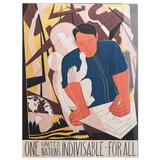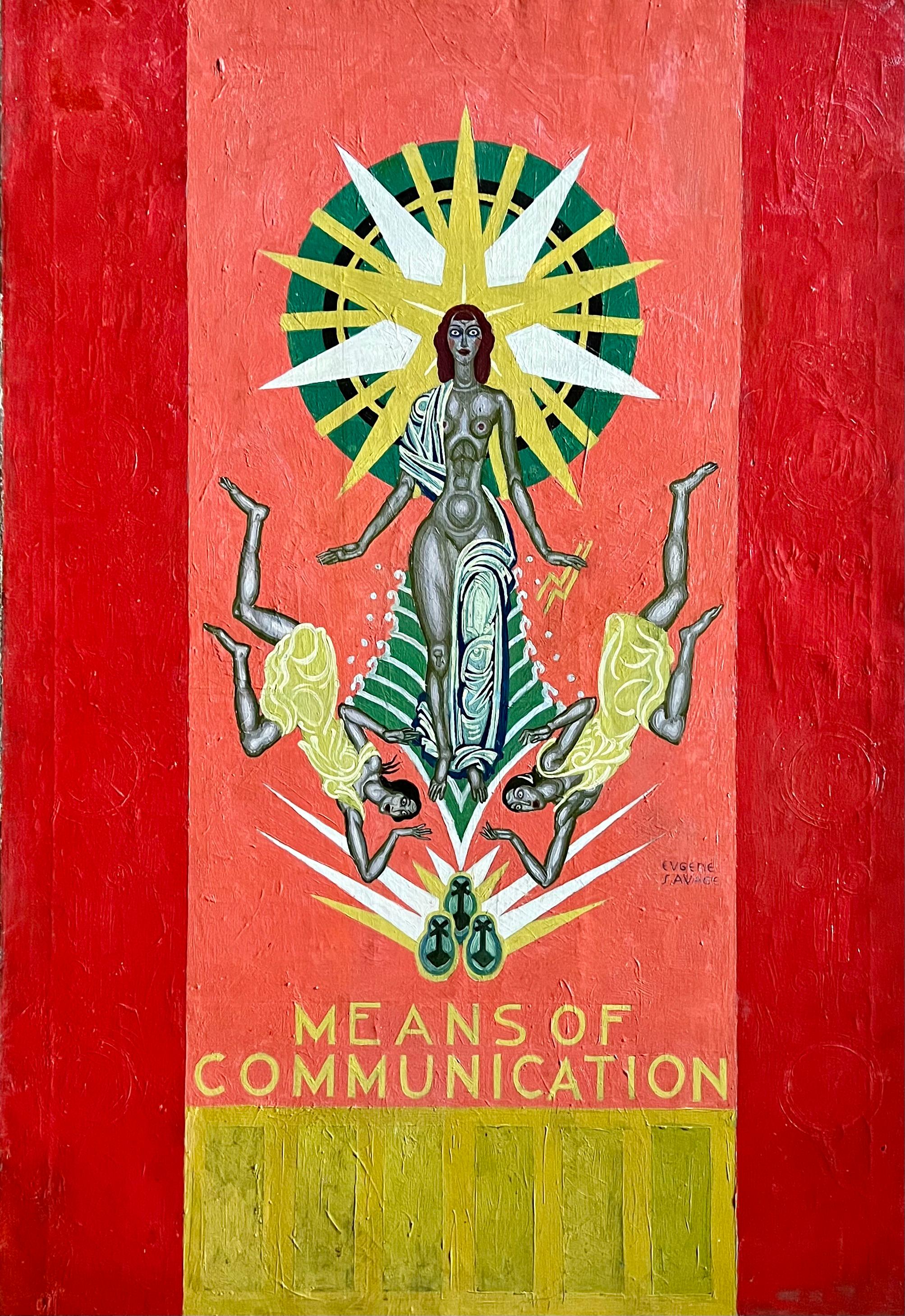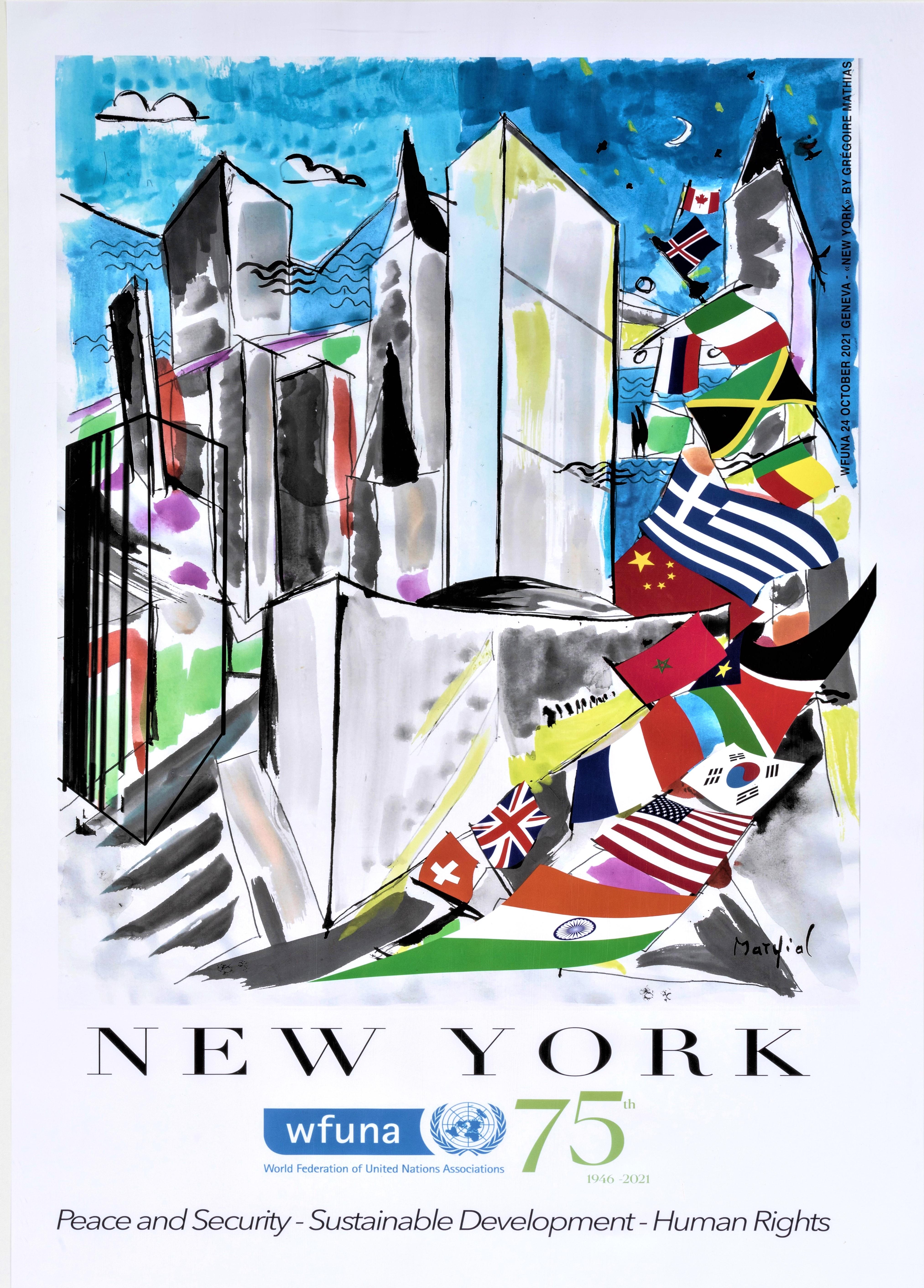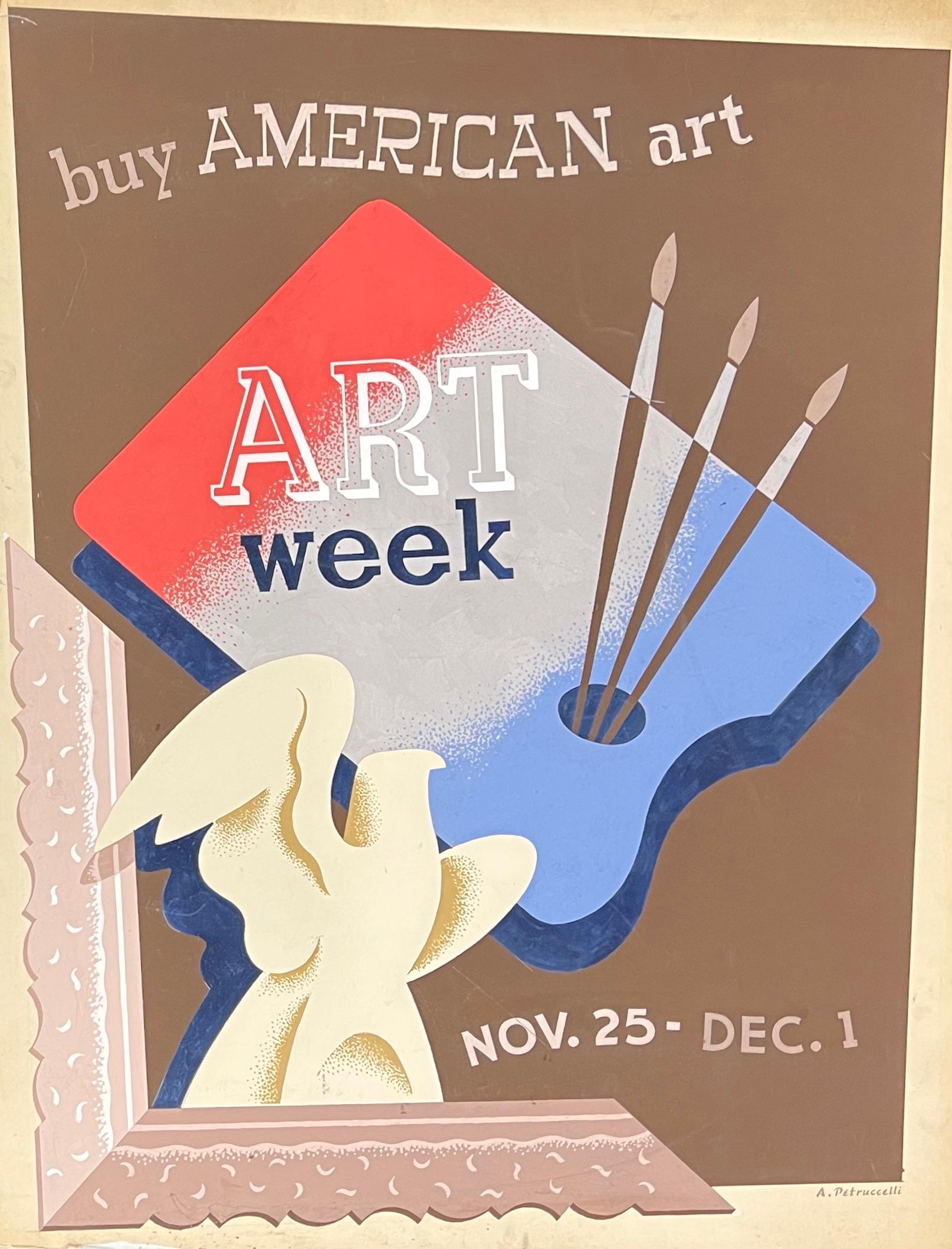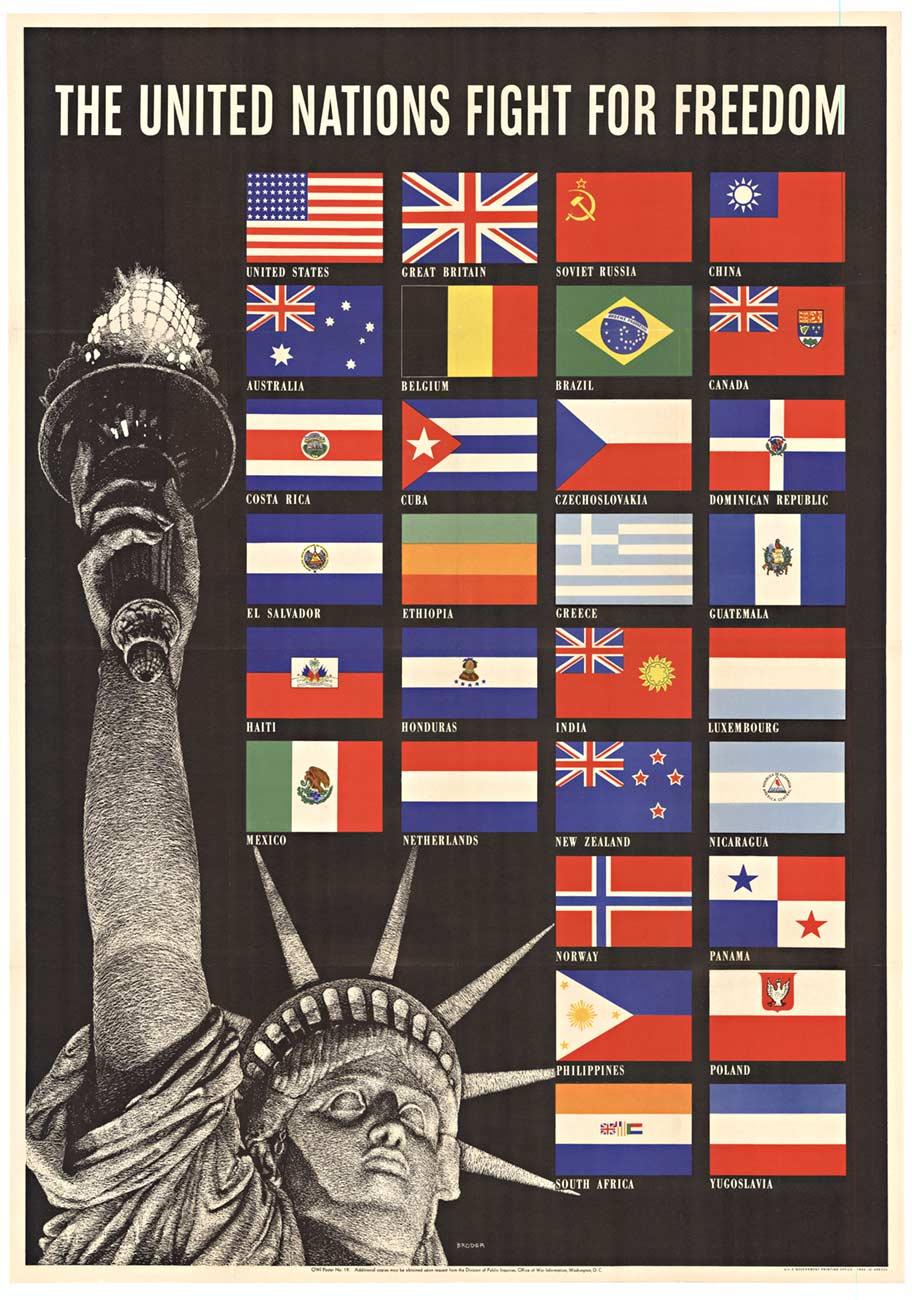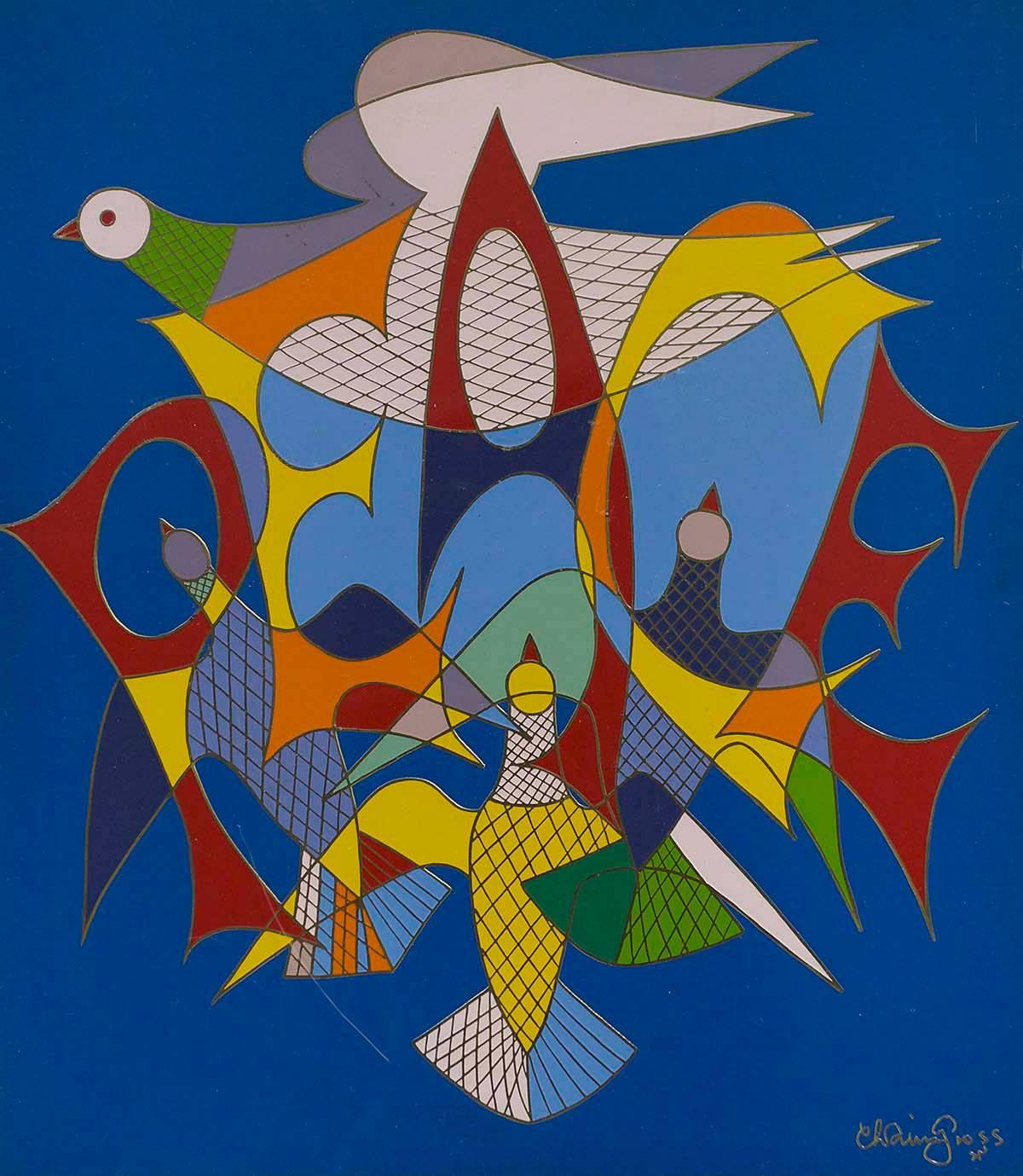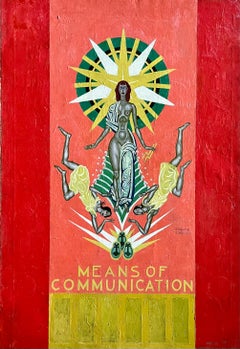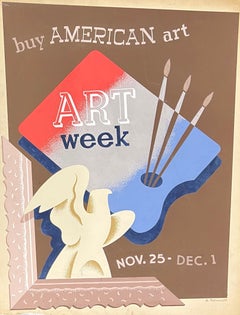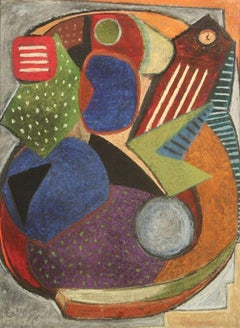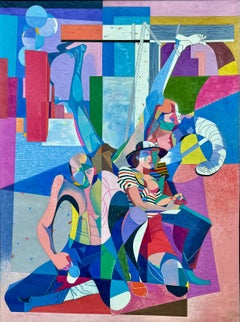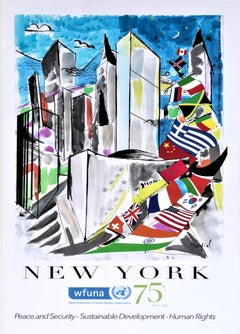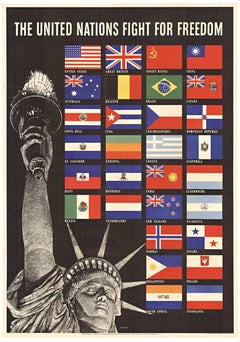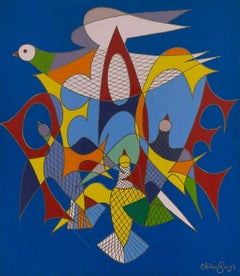Items Similar to UN Poster Design American Scene Mid 20th Century Modernism WPA World Peace
Video Loading
Want more images or videos?
Request additional images or videos from the seller
1 of 9
Jo CainUN Poster Design American Scene Mid 20th Century Modernism WPA World Peacec. 1945
c. 1945
$29,500
£22,613.87
€25,883.45
CA$42,139.54
A$46,214.12
CHF 23,943.55
MX$555,298.91
NOK 301,407.02
SEK 282,879.10
DKK 193,373.39
About the Item
UN Poster Design American Scene Mid 20th Century Modernism WPA World Peace
Jo Cain (1904 – 2003)
We Are All Members of the Human Race: UN Poster Proposal
21 x 16 inches
Tempera on board, c.1945
Estate stamp verso
30 x 25 inches framed
Our gallery is pleased to present the exhibition, "Jo Cain: Echoes of an Era," a tribute to the enduring legacy of Joseph Lambert Cain and a celebration of his art that transcends time and remains relevant today. The exhibition features mural studies, works on paper and paintings from the 1930s and 40s, all are available on 1stDibs.
BIO
JOSEPH LAMBERT CAIN (1904–2003)
A painter, muralist, and art educator, Joseph Cain's work was consistently infused by the color and vibrancy of his native New Orleans, even as he pursued a career that took him far from home. Beginning at the age of sixteen, his educational journey led him first to the Art Institute of Chicago and then to the Art Students League in New York, where he was instructed by Kenneth Hayes Miller, Kimon Nicolaides and Vaclav Vytlacil. He later studied under the Abstract Expressionist Hans Hoffman. A 1929 Carnegie Fellowship funded a year's enrollment at the Sorbonne in Paris and travel throughout Europe; Cain also received multiple Tiffany Foundation Fellowships.
Using thickly applied paint, layered color planes, and multiple perspectives, Cain created paintings, including streetscapes, marine scenes, and landscapes, which were sometimes categorized as "decorative expressionism" beginning in the late 1930s.
In 1932, Cain's entry to the First Biennial Exhibition of Contemporary American Painting at the Whitney Museum of American Art hung in the exhibition's entry way; other works were shown at such prestigious venues as the Museum of Modern Art, American Art, Pennsylvania Academy of the Fine Arts, National Academy of Design, and Carnegie Institute.
He also executed a monumental mural at New York State Training School where he was employed as a teacher. While living in New York during this period, Cain was an integral member of a contemporary art collective known as "The Group," whose participants included Milton Avery, George Biddle, Robert Gwathmey, Marsden Hartley, John Marin, and many other important modernists.
Jo’s work evolved continuously. Moving from realism in the ‘20’s, he developed a highly personal, cubism based, abstract style similar in spirit to that of Stuart Davis and clearly influenced by Leger, Matisse and Picasso. In 1944, Cain joined the faculty at the University of Rhode Island, establishing and chairing the art department for over two decades. He continued creating art until his death.
- Creator:Jo Cain (1904)
- Creation Year:c. 1945
- Dimensions:Height: 30 in (76.2 cm)Width: 25 in (63.5 cm)Depth: 2 in (5.08 cm)
- Medium:
- Movement & Style:
- Period:
- Condition:
- Gallery Location:New York, NY
- Reference Number:1stDibs: LU1156213258072
About the Seller
5.0
Gold Seller
Premium sellers maintaining a 4.3+ rating and 24-hour response times
Established in 2008
1stDibs seller since 2019
195 sales on 1stDibs
Typical response time: <1 hour
- ShippingRetrieving quote...Shipping from: Pawling, NY
- Return Policy
Authenticity Guarantee
In the unlikely event there’s an issue with an item’s authenticity, contact us within 1 year for a full refund. DetailsMoney-Back Guarantee
If your item is not as described, is damaged in transit, or does not arrive, contact us within 7 days for a full refund. Details24-Hour Cancellation
You have a 24-hour grace period in which to reconsider your purchase, with no questions asked.Vetted Professional Sellers
Our world-class sellers must adhere to strict standards for service and quality, maintaining the integrity of our listings.Price-Match Guarantee
If you find that a seller listed the same item for a lower price elsewhere, we’ll match it.Trusted Global Delivery
Our best-in-class carrier network provides specialized shipping options worldwide, including custom delivery.More From This Seller
View AllNYC 1939 World's Fair Mural Study American Scene WPA Modern Mid 20th Century
Located in New York, NY
NYC 1939 World's Fair Mural Study American Scene WPA Modern Mid 20th Century
Eugene Savage (1883 – 1978)
1939 World’s Fair Mural Study
45 x 30 inches
Oil on Canvas
Signed lower right
The painting is part of a 1,000 piece collection of art and objects from the 1939 World’s Fair. The collection as a whole is available.
Savage created the mural for the facade of the Communications Building. An image of the completed mural, along with a published postcard, is part of the listing. Note the center top female figure, she resembles the figure in the offered painting.
BIO
Eugene Francis Savage was born in Covington, Indiana 1883. He underwent various forms of art training in the early years. He was a pupil of The Corcoran Gallery and The Art Institute of Chicago, and was later awarded a fellowship to study in Rome at The American Academy.
While under the spell of that ancient city the young artist began to render historic figures that were suitable for the classic style needed for mural painting in the traditional manor. During this period he was able to study and observe Roman and Greek sculpture, although much of the academic training was accomplished by using plaster casts along with the incorporation of live models. This method survived and was used efficiently throughout Europe and the United States.
After leaving the Academy, Savage was commissioned to paint numerous murals throughout the United States and Europe. This artist received acclaim for the works he produced while under commissions from various sources. This young master was a contemporary of Mexican muralists David Alfaro Siqueiros (1896-1974), Jose Clemente Orozco (1883-1949) and Diego Rivera (1886-1957). In this period he was to show the influence of his contemporaries in formulating a modern style. Savage also played a vital role in the WPA Federal Art program, and he was a member of The Mural Art Guild..
Savage was elected an associate member of The National Academy of Design in 1924 and a full member in 1926. From 1947, he held a professorship at Yale University where he taught mural painting, and some of his students went on to significant positions.
By this time the artist had painted large-scale murals at Columbia, Yale University, Buffalo N.Y., Dallas, Texas, Chicago, Indiana, along with other commissioned works. He also achieved recognition for a series of murals commissioned by the Matson Shipping Line and completed around 1940. For this commission, Savage made many exacting studies of customs and folkways of the Hawaiian natives. However, the award-winning murals were not installed as planned but were put in storage during the war years when the ships were used for troop transportation and were in danger of attack.
However the mural images were reproduced and distributed by the shipping company including nine of the mural scenes that were made into lithographed menu covers in 1948. The American Institute of Graphic Arts awarded certificates of excellence for their graphic production, and the Smithsonian Institute exhibited the works in 1949. Today Savages' Hawaiian Art production is held in high regard by collectors of Hawaiian nostalgia.
In later years the artist focused his attention on a theme that dealt with the customs and tribal traditions of the Seminole Indians of Florida. He produced many variations of this theme throughout his lifetime, and the pictures were usually modest scale easel paintings, precise and carefully delineated. Many of these pictures incorporate Surrealistic elements and show some minor stylistic influences of the painters Kay Sage...
Category
1930s American Modern Figurative Paintings
Materials
Canvas, Oil
Art Week Poster Design American Scene Modern c. 1930s WPA Era Illustration
By Antonio Petruccelli
Located in New York, NY
Art Week Poster Design American Scene Modern c. 1930s WPA Era Illustration
Antonio Petruccelli (1907 - 1994)
Art Week
22 X 17 inches
Gouache on board, c. 19...
Category
1930s American Modern Landscape Paintings
Materials
Gouache, Board
Abstract Mid 20th Century WPA Non Objective American Modernism New Hope Modern
By Louis Stone
Located in New York, NY
Abstract Mid 20th Century WPA Non Objective American Modernism New Hope Modern.mixed media. 21 x 16 (sight). Housed in a hand carved frame.
Louis King Stone ...
Category
1940s American Modern Mixed Media
Materials
Gouache, Board
Figurative Cubist Surrealist Abstraction Mid 20th Century American Modern Large
By O. Louis Guglielmi
Located in New York, NY
Figurative Cubist Surrealist Abstraction Mid 20th Century American Modern Large
O. Louis Guglielmi (1906 - 1956)
OBSESSIVE THEME
44 x 33 inches
Oil on canvas
Signed and dated '48 lo...
Category
1940s American Modern Abstract Paintings
Materials
Canvas, Oil
Abstract American Modernism Mid-Century WPA Era Drawing Woodstock 20th Century
By Konrad Cramer
Located in New York, NY
Abstract American Modernism Mid-Century WPA Era Drawing Woodstock 20th Century, Sight size is 16 x 12 inches.
Konrad Cramer (1888-1963)
Abstract
Mixed media on paper
17 x 12 inches
...
Category
1930s Abstract Abstract Drawings and Watercolors
Materials
Paper, Ink, Watercolor
MODERNIST ABSTRACT Mid-Century New Hope Non-Objective oil American Modern WPA
By Louis Stone
Located in New York, NY
MODERNIST ABSTRACT Mid-Century New Hope Non-Objective oil American Modern WPA
Louis Stone (1902-1984) "Abstract," 16 X 12 inches. Oil on canvas, signed lower right.
An abstract pai...
Category
1940s Abstract Abstract Paintings
Materials
Canvas, Oil
You May Also Like
"One United Nations Indivisible, " Stunning, Original Painting for UN Poster
Located in Philadelphia, PA
A striking example of graphic design in the 1940s, which was moving from elegant Art Deco stylization to a looser, collage-like assemblage of overlapping images, this original painti...
Category
Vintage 1940s American Mid-Century Modern Paintings
Materials
Gouache
Original Poster United Nations New York 2021 / Affiche Originale ONU
Located in PÉRIGUEUX, FR
Cette affiche fut réalisée pour la World Federation of United Nations Associations – WFUNA (Fédération Mondiale des Associations pour les Nations Unies), à l'occasion des 75ème anniversaire de la création de l'ONU à New-York. Il a eu lieu le 24 octobre 2021. Grégoire MATHIAS...
Category
21st Century and Contemporary Modern Figurative Prints
Materials
Color
Original "The United Nations Fight For Freedom" vintage poster 1942 WWII
Located in Spokane, WA
Original "The United Nations Fight For Freedom" vintage World War II poster. Printed in 1942. Artist: Steve Broder. This is the large format version of the poster.
Archival linen backed in very good condition with no paper loss. Bright and vibrant lithographic colors. World War II posters issued by the U. S. Government printing office...
Category
1940s American Realist Portrait Prints
Materials
Lithograph
Peace Mid-Century Modern Pop Art Enamel Painting Chaim Gross Modernist Ltd Ed
By Chaim Gross
Located in Surfside, FL
Mod, Hippie era Peace art.
Chaim Gross, born in Wolowa, Austria in 1904, was educated at the Beaux Arts Institute of Design and at the Art Student's League in New York. Chaim Gross's work was greatly influenced by his experiences during a period of international conflict, World War II. He had moved to Kolomyia from Wolowa to get a better education, but the Germans came to occupy, killing, raping, and looting. Gross and his family were chased from one village to
the next. He wrote, "We were sleeping on roofs and in the fields, with the sound of cannon fire always in the distance,". Eventually, he ended up in Budapest with his two brothers, where Anti Semitism was not as severe, and that is where he began to sculpt and draw. He even had a few odd jobs there as a gold and silversmith. When he was seventeen, Gross immigrated to America where his older brother was. There he was a student and then a teacher at the Educational Alliance on the Lower East Side. Teaching became a big part of his philosophy, as he believed that an artist must pass on the knowledge which he had received from others in his artwork.
He was part of an artist emigre community which included Raphael Soyer, Moses Soyer, Arnold Newman, Max Weber and David Burliuk. His daughter is the artist Mimi Grooms and his son in law was Red Grooms.
Chaim Gross works reflect his Jewish and Austrian roots and his Hasidic Jewish upbringing. The figures in his art reflect the Hasidic spirit of being happy and making other people happy. In his pieces, Jews sing and dance in celebration of the Jewish Sabbath and festivals. They are shown rejoicing in the great gifts of love and life. Chaim Gross was honored with a number of prestigious awards including: the Award of Merit Medal from the National Institute of Arts and Letters in 1963, and the Gold Medal award from the National Academy of Design in 1985. He often used his creative abilities to explore and experiment with media. In his artwork he retains an optimistic philosophy, even when facing somber issues such as war, depression, and the Holocaust.
He is in the collections of the Museum of Modern Art; the Metropolitan Museum of Art; the Whitney Museum of American Art; the Philadelphia Museum of Art; the Art Institute of Chicago; the Tel Aviv Museum of Art, Israel. And the EIN HAROD Museum's Holdings: Israeli art is represented by the works of Reuven Rubin, Zaritzky, Nahum Gutman, Mordechai Ardon, Aharon Kahana, Arie Lubin, Yehiel Shemi, Yosl Bergner and others.
The graphic arts collection contains drawings and graphic works by Pissaro, Amedeo Modigliani, Jules Pascin, Marc Chagall (almost all of his graphic work), and numerous other artists. The sculpture collection includes works by Jewish sculptors from all over the world including leading Israeli sculptors; Ben Zvi, Lishansky, David Palombo, Yehiel Shemi, Aharon Bezalel and Igael Tumarkin. Many Jewish sculptors from all parts of the world, beginning with Mark Antokolsky, are represented in the collection. In the sculpture courtyard there are works by Chana Orloff, Jacob Epstein (the works he bequeathed to the Museum), Enrico Glicenstein, Loutchansky, Joseph Constant and Leon Indenbaum from Western Europe; Glid from Yugoslavia; William Zorach, Chaim Gross and Minna Harkavy from the United States; and most of the outstanding sculptors of Israel : Zeev Ben-Zvi, Lishansky, Ziffer, Rudi Lehmann, Dov Feigin, Sternschuss, David Palombo ( who executed the iron gate...
Category
Mid-20th Century Modern More Art
Materials
Metal
Abstract Form, vintage poster design by M R Webb
Located in London, GB
M R Webb
Abstract Form
21 x 26 cm
Signed to lower right
Provenance: Family of A. E. Halliwell
Little is known about A Searle beyond the fact that he studied under A E Halliwell, th...
Category
1940s Abstract Abstract Paintings
Materials
Gouache
Original Vintage Poster International Overseas Exhibition Paris 1931 France
Located in London, GB
Original vintage poster advertising the International Overseas Exhibition Paris 1931 featuring a colourful design by Victor Jean Desmeures (1895-1965) of four men from different coun...
Category
Vintage 1930s French Art Deco Posters
Materials
Paper
More Ways To Browse
An American In Paris Poster
Peace Poster
Peace Posters
John Stuart Mid Century Chair
Mid Century Poster Design
Kimon Nicolaides
Wpa Posters
Mother Daughter Art
Oil Painting Children Playing
Oil Painting Mask
Oluwole Omofemi
Sean Brown
Social Commentary Paintings
Vintage Beach Woman
Vogue Painting
Blue Tit
Drowning Art
El Mac
